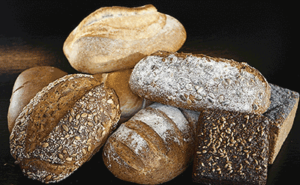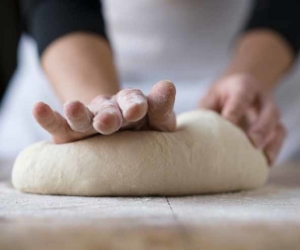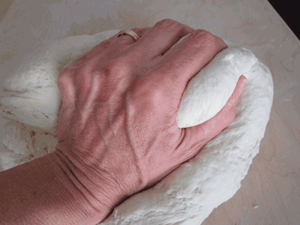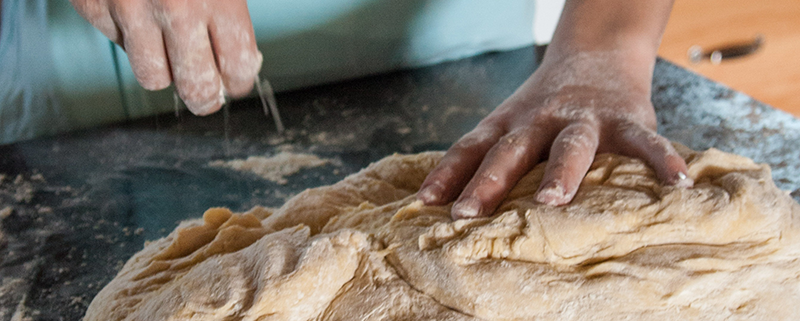The Aroma of Rising Bread
There are few delights more complete than homemade bread. You feel it get silky as you knead. You take delight in the magic of little yeasties turning a lump of dough into a taut risen bubble ready to shape into loaves. You enjoy its yeasty odors, different while rising than while baking. At last, four hours later, you wait for a pat of butter to melt before crunching through crispy crust into the melting insides fresh-baked bread.
The first few times a person does anything are daunting, right? With bread, you’ll soon find an easy rhythm to weave among other activities during an at-home afternoon.
Today’s recipe aims to de-mystify the process of baking bread so you can join the legion of “I made it” bread mavens. Before long, you’ll create your own mixes, shapes, and tastes in home-baked bread.
Basic Yeast Bread
makes 2 regular-sized loaves

Ingredients
2 cups water
2 TBSP yeast
2 tsp salt
1 TBSP sugar, honey, sorghum, or molasses
2 TBSP fat (butter, lard, coconut oil,…)
6 – 8 cups flour
Sprinkle dry yeast on the surface of the water and wait until it reconstitutes and makes a shiny scum on the surface – about 5 minutes. While waiting, you can add salt, sweetener, and fat, but don’t stir. You can also turn the oven to its lowest setting to create a warm proofing area.
Stir by hand or in your sturdy stand mixer and begin adding flour, a cup at a time, mixing like mad all the time. The dough has enough flour when it forms a central ball and pulls away from the sides of the bowl.
Remove the dough and knead for 10 minutes or so, until the surface turns satiny and the texture elastic. You’ll feel it when it happens. Gather into a tight ball.
Pour a bit of oil into the (un-meltable) bowl you mixed in and coat the ball on all sides. If you heated the oven, remember to turn it off. Cover bowl with a damp towel and close it into the warm, dark oven.
In about 45 minutes, the dough will have risen double. If you carefully press a finger in, the depression remains. Punch your whole fist into the center.
Knead 5 – 10 minutes on a floured surface, until the dough is again satiny and elastic. Re-oil the bowl and dough and return to the oven.
In about 20 minutes, the dough has redoubled. Punch it.
Divide the recipe in two, form balls, and coat each all around in flour.
One at a time, briefly knead. In a couple of minutes, the loaf will not stick to the kneading surface: time to form loaves.
Place loaves in greased loaf pans, cover loosely, and let rise double one more time.
Most recipes call for a preheated oven, which means the loaves’ final rising is on the counter or stove top. Instead, I place the loaves in the oven when not quite risen double and turn it on. The rising temperature completes the rising, then kills the yeast.
Bake 35 – 40 minutes at 375°F.
Loaves are done when they separate from the sides of the pan and emit a hollow sound when you knock on them.
For a softer crust, brush tops immediately with butter, then turn them onto racks to cool. For a crisper crust, brush tops with water, instead.
Leave them at least 10 minutes before grabbing an end and the butter dish.
If you declare baking day and make a lot of bread, let the loaves cool completely, then slice, package, and freeze what you can’t eat in two days.
Notes
If you want more loaves, double this recipe, but if you want more than than, make multiple batches of two to four loaves.
Use a portable hand mixer only through the initial ingredient mixing and a third of the flour. Adding flour to a stiff dough quickly kills your portable mixer.
1 packet of yeast = 1 TBSP. Of course, you can use a sourdough started in place of or in addition to yeast.
For water you may use any liquid, including milk, yogurt plus water, juice, canned fruit syrup. Each liquid imparts its own flavor.
Freely mix your favorite flours with gluten: unbleached, 100% whole wheat and “white” whole wheat blend, as well as white flour. Experiment with flours from red and heirloom wheat. Graham flour is coarse-ground 100% whole wheat. Self-rising flour contains salt and baking powder or baking soda: add yeast or save this for quick breads.
Perk up the flavor and appearance with additives like oats, cornmeal, buckwheat, millet, quinoa, nut and other specialty flours, and sprouted grains or seeds. Don’t forget that seeds, nuts, and fruit add pizzazz.
Finally, this process requires gluten-bearing flour. Cells of gluten capture air to make the bread rise. Rye flour has very little gluten. Combine it 1 part to 3 parts regular or equal amounts of rye and regular.
Gluten-free yeast bread baking can be the topic of an upcoming recipe.
General Variations
Sweet bread tends to have more fat and sugar, a little less flour, and might add eggs or additional leavening agent. You mix to a softer dough before turning it out and kneading.
Sourdough breads require a starter from a friend or creating your own starter from yeast-bearing potions. I’ve made starters from potato peels and water and by saving a bit of soft dough from a batch of bread and nurturing it for a few weeks.
Making French bread is dead easy. The trick is a baguette pan to give loaves loft and more surface area, as do the traditional diagonal slits. I also brush the surface of the risen loaves with water just before their 25-minute baking process is done. For surface shine, place a cast iron pan in the oven when you preheat and pour a cup of water in it when you add the loaves. Omit brushing the baked loaves’ surfaces with butter. I learned a special way to form baguette loaves from a real baker that nearly doubled the height of my finished loaves. I now adapt this method for almost all bread I bake.
Pizza dough is basic bread with a little extra oil and more flour. A two-loaf recipe makes four large, thick pizza skins. Keep adding flour until you just can’t add more. Be sure the first kneading is very thorough.
Make simple rolls by shaping the twice-risen dough into small balls or other shapes, or by placing in an oiled muffin pan. Many sweet and dinner roll recipes call for more eggs and fat, maybe more sweetener, and sometimes additional ingredients. Nicole Sauce’s grandfather taught me a method for forming high-lofted rolls that I’d be glad to pass on.
Prairie bread is stuffed with seeds, uses only whole-grain flours, is formed into round loaves, and is baked on a stone instead of in a pan.
“Travel” breads have a coarser texture but take half the time to create, because let them rise only once. You simply let them sit a few minutes, then shape loaves, let rise, and bake.



